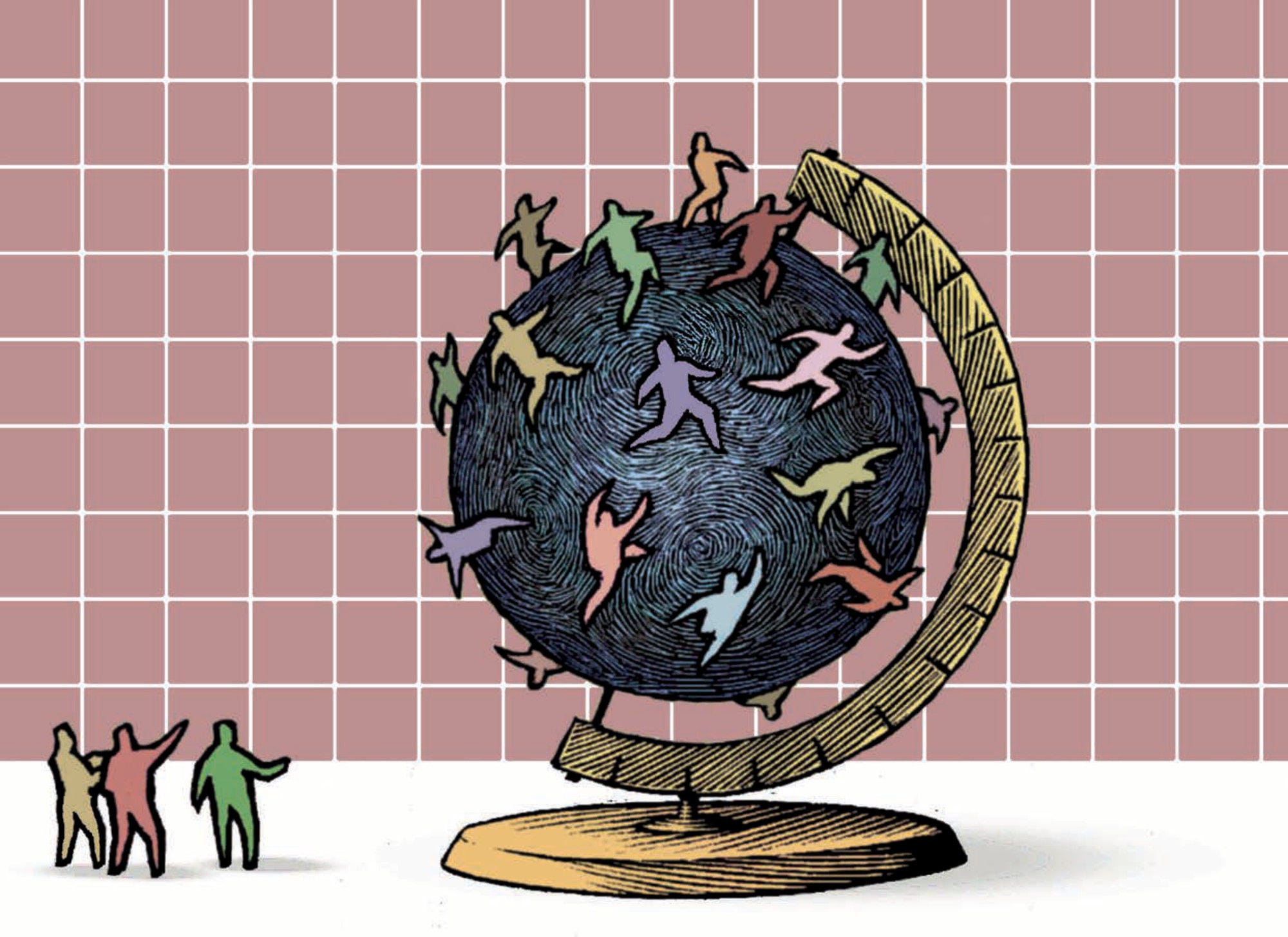The 2020 edition of International Migration Outlook analyses recent developments in migration movements and policies in OECD countries and some non-member countries, and looks at the evolution of the labour market outcomes of immigrants in OECD countries. It includes a special chapter on the impact of migration on the structural composition of the economy. It also includes country notes and a statistical annex.
International Migration Outlook 2020

Abstract
Executive Summary
Migration flows were stable in 2018 and 2019, but halted in the first half of 2020 due to the COVID‑19 pandemic
OECD countries, with the exception of Colombia and Turkey, together accepted about 5.3 million new permanent migrants in 2019. This represents a stable level compared to 2018. Flows to the United States and Germany (the top OECD receiving countries) continued to decrease, while in most other OECD countries flows tended to increase, notably in Spain and Japan.
Initial estimates of migration flows in 2020 suggest that the COVID‑19 pandemic has had a major impact on migration flows in the first half of the year, with the number of new residency permits granted to migrants down by 46% on average in the OECD. Part of the effect might be offset by a rise in flows during the second half of the year, notably for international students, but the current economic downturn will also most likely aggravate the impact on labour migration. Overall, 2020 is projected to be a historical low for international migration in the OECD area.
After two years of decrease, the number of asylum applications to OECD countries rebounded 11% in 2019, reaching 1.2 million. The number of asylum applications remained, however, much lower than the record highs of 2015 and 2016. About half of all asylum applications in the OECD were made in OECD European countries. More than 20% of all asylum seekers came from Afghanistan, Venezuela and Honduras, while asylum requests from Middle East countries were now at their lowest level since 2013‑14.
Partial data on the number of newly accepted refugees in OECD countries in 2019 showed an overall 25% drop. Permanent labour migration rose sharply (+13%) and family migration remained relatively stable.
Temporary labour migration, when a person migrates for limited time to do a specific job, continued to increase in 2018, reaching 5.1 million, compared with 4.8 million in 2017. Preliminary data indicate that this upward trend continued in 2019. Poland was the top temporary labour migration destination, followed by the United States. The main categories of labour migration were: posted workers within the EU/EFTA (1.7 million), working holidaymakers (475 000) and seasonal workers (323 000, not counting Poland). In 2018, more than 1.5 million visas were granted to tertiary-level students, 3% more than in 2017. Flows of tertiary-level students rose in 2019 as well, notably in Europe.
COVID‑19 impact may hamper progress on labour market inclusion
The labour market outcomes of immigrants continued to improve in 2019. On average, more than two‑thirds of immigrants were employed and about 8.2% were unemployed, a 0.5 percentage point decrease compared to 2018.
However, the economic consequences of the COVID‑19 pandemic may set back the progress in the labour market inclusion of immigrants in OECD in recent years. Early, partial evidence shows that the pandemic has revealed and reinforced vulnerabilities of migrants in the labour market. Migrants are for example more likely to hold temporary contracts and tend to be concentrated in sectors more affected by the pandemic and its economic consequences. Migrants may also be disproportionally impacted by COVID‑19/health concerns due to higher proportions working in sectors with high COVID‑19 exposure.
Immigrant women remain at higher risk of exclusion from the labour market and may be particularly vulnerable in the current context due to their share of temporary contracts. They are overall more prone than native-born women to be in long-term unemployment, in involuntary inactivity and to be “not in employment, formal education or training”. They are also more at-risk of being over-qualified for the work they do.
Adjusting migration programmes and fostering integration in 2019
The bulk of 2018‑19 labour migration management measures and reforms addressed emerging needs among highly and medium-skilled occupations. Some European countries, notably Germany, significantly enlarged their shortage occupation lists and/or relaxed the requirements in terms of minimum educational attainment to recruit migrant workers from abroad. Measures concerning asylum seekers mainly focused on reducing processing times. A limited group of receiving countries eased their entry conditions and access to the labour market while many others put in place stricter conditions.
OECD countries continued to design and fine-tune comprehensive integration programmes for newcomers, to facilitate their rapid labour market integration and their access to basic social services.
Due to the COVID‑19 pandemic, in most countries migration and asylum offices as well as consular services abroad were closed for one to three months in the first half of 2020, leading to a quick increase in backlogged applications. Nevertheless, in some countries the pandemic accelerated re-organisation, digitalisation and/or simplification of administrative procedures measures. Return and resettlement activities have de facto been suspended in most countries.
The impact of migration on sectoral development
Migrants – and especially recent arrivals – are not equally distributed across the economy. They are strongly concentrated in a number of sectors, especially in low-skilled services, but also in information technology (IT) and manufacturing in some countries, and sectoral concentration of migrants has tended to grow since 2005. Few OECD countries currently have strong sectoral migration policies, with the exception of agriculture where almost half of all countries have specific policies to promote seasonal labour migration to this sector. Migration has sectoral implications – whether these are intentional or not. To be aware of this dimension is a precondition for reaping intended sectoral benefits as well as for avoiding unintended adverse impact. This is particularly important in the current context, as the economic consequences of COVID‑19 has affected some sectors more than others.
Key findings
Permanent migration flows to OECD countries remained stable in 2018 and 2019 and reached about 5.3 million (bar Colombia and Turkey). First indications show that it might plummet by as much as 46% over the first semester of 2020 as a result of the COVID‑19 pandemic.
More than 5.1 million labour migrants entered OECD countries on temporary migration programmes in 2018, a 5% increase over 2017. This trend continued in 2019, but a sharp drop is expected in 2020.
In 2019, immigrant unemployment rate in the European Union dropped below the symbolic threshold of 10% for the first time and was less than 4 percentage points higher than that of the native-born. Immigrant unemployment rates were lowest in Canada and the United States, at about 3%. COVID‑19 has however reverted this trend, jeopardising more than a decade of progress in migrant labour market inclusion in OECD countries.
In OECD European countries, Israel and the United States, migrants are strongly over-represented in services sectors with high shares of lower-skilled workers, especially in domestic services, and accommodation and food services. In Canada, Australia and New Zealand, while migrants are also over-represented in hospitality and support service activities, many migrants work in sectors with a high share of highly skilled jobs, especially the IT sector in Canada (33%) and finance in Australia (37%). In all OECD countries, with the exception of New Zealand, migrants are under-represented in public services, notably public administration and defence.
In the same series
Related publications
-
 4 September 2024
4 September 2024 -
 28 June 2024
28 June 2024 -
 11 June 2024
11 June 2024








